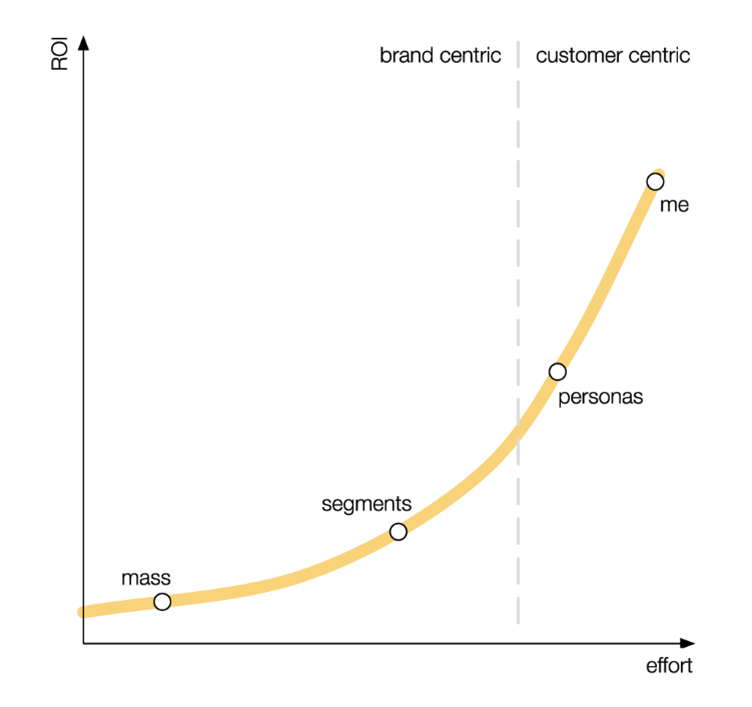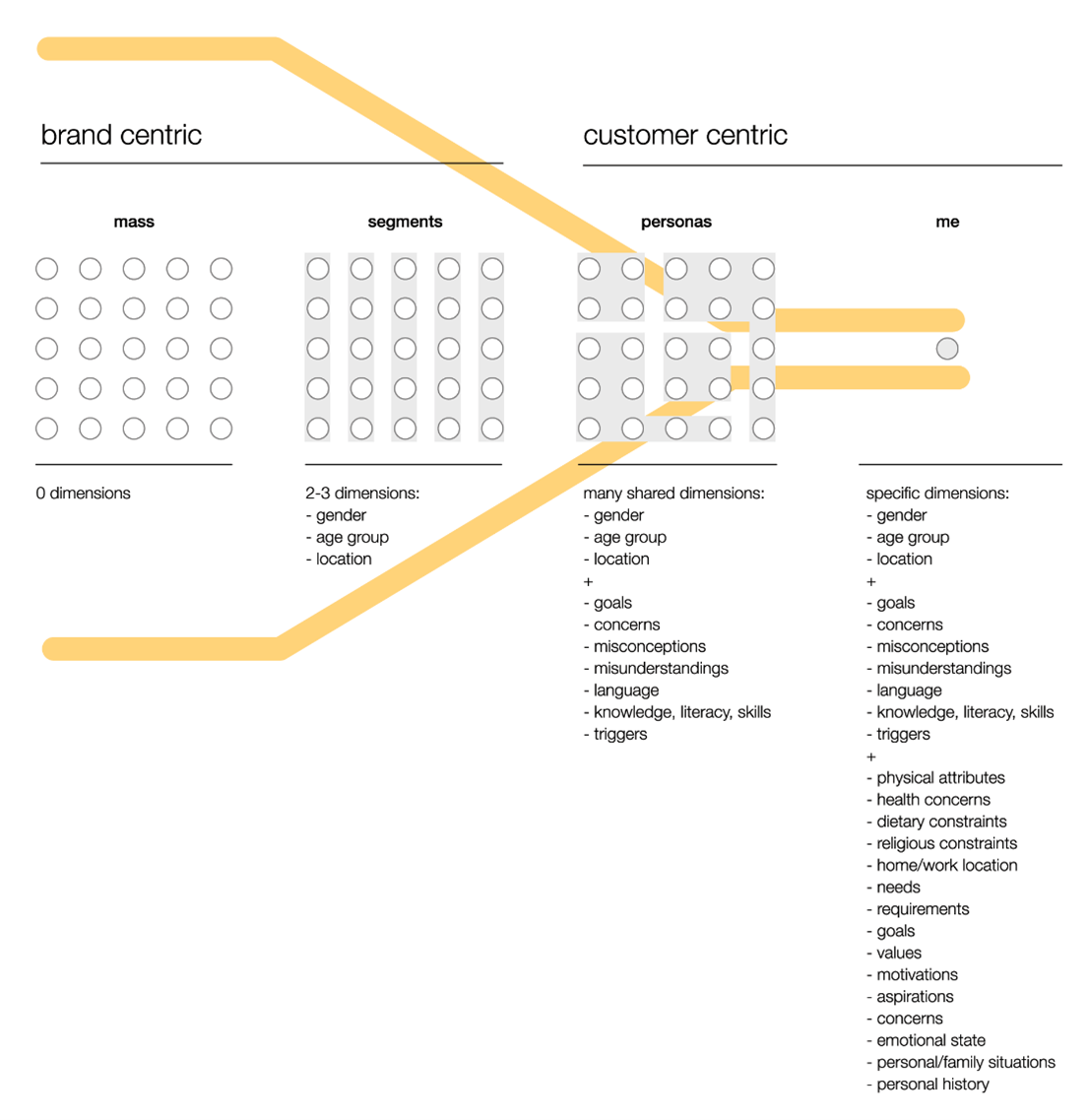A Brief History of Personalization: From the General Store to Generative AI
Much of my career has been devoted to the exploration of personalization. Searching for answers to one essential question: How we make our content, our marketing, our service, and our products more relevant and more personal?
Twenty or so years ago, about midway in my career, I published a book on personalization titled Talk to Me! It was written back in the day when print was still a thing and digital was first emerging. Personalization also became the topic of my TEDx talk on building Sustainable Customer Relationships.
“While we ever hope to get closer to our customers, wave after wave of innovation pushes us relentlessly away.”
The origins of personalization can be traced back to the 18th and 19th century General Store, a type of retail establishment that was ubiquitous throughout rural and small-town North America.
The shop owners who served these small communities knew their customers on a first-name basis. As a result, their inventory and their customer service reflected that close personal relationship and profound understanding of the customers’ needs.
With the advent of supermarkets, and later big box stores, this personal connection to the customer was lost. The need, ever present, remained unfulfilled.
But gradually technology and marketing practices began to fill the gap. Direct-to-consumer and database marketing arose to fill the gap enabling individualized messages to be sent to customers.
High output laser printers and variable data printing (VDP) enabled direct mail that was fully customized to the reader. At first it was simply the insertion of a persons’ name multiple time in the text. Or integrating a few personal data points to the content.
True Personalization Remains Elusive
What I realize now after so many years is that true one-on-one personalization remains elusive despite the technological advances of the past four decades.
As a matter of fact, the major waves of changes in the marketing environment have actually set back the advancement of personalization rather than enable it.
Here are some examples of competing “technology” that stalled the advancement of personalization. There are two competing forces: Mass marketing on the one hand, and One-on-One marketing on the other.
Each wave of new technology seeks to re-enable Mass Marketing (i.e. Batch and Blast) in a new way. Marketers’ fascination with Reach and a Universal Message tends to eclipse or stall most attempts at an individualized approach to marketing communication. Buzz is created, budgets get reassigned. Babies are thrown out with large quantities of bathwater.
|
Platform |
Competing Tech |
|
General store |
Supermarket and Big Box Stores |
|
Offset printing (offset plus impact) |
Dynamic digital printing |
|
Mass marketing |
One-to-one marketing |
|
Direct mail |
|
|
Email (I know, I know, email isn’t dead) |
Social media marketing |
|
Dynamic content and microtargeting |
GenAI (it can do everything, right?) |

Cosmetic versus Substantive
For about a decade in the early 2000s it became fashionable to add the customer’s name to images. It’s what we like to refer to as Skywriting personalization – your name printed in a cloud in the sky. Litmus even has a handy guide on how to do this. Obviously, this is no more than window dressing designed to draw attention to the message because people love to see their name in print.
Personalization that really impacts results goes beyond cosmetic use of data. It uses data to change the content, the tone, the targeting and the product being featured.
Factors that limit the adoption of true personalization
If it were easy, everyone would be doing it, right? But it’s not. Particularly since it requires a high level of 3-dimensional thinking and a profound understanding of the customer. Here a a few roadblocks that get in the way.
Complexity: Let’s face it, personalization is hard, particularly compared to a social media post. And it feels like Email is hard enough without the added layer of complexity.
You need to orchestrate content based on customer attributes, behavior and preferences. So much to do, so little time.
Technology: Creating the content is one thing, but being able to execute it is another. Your ESP must have a decent dynamic content engine that would enable the customization of messages at scale and at an acceptable speed.
Rendering these complex messages can slow down many platforms, which weren’t designed to call upon la large number of data fields and content assets.
Quality Assurance Risks: When the number of combinations and permutations approaches the thousands or even the millions, ensuring that the content is error-free becomes a challenge.
The risk of errors increases exponentially because it is physically impossible to vet each possibility.
Fear of Creepiness: The closer you get to one-on-one marketing, the greater the risk of Big Brotherism. And the more questions you ask and data you collect, the greater the risk of consumers pushing back.
Make sure the reward of personalized content is worth the price of the effort you ask of your customers.
Lack of Institutional Knowledge: Only a handful of individuals in an organization actually have the full story on which products are right for which customer.
Get the product development team involved will help.
Let Them Decide: In addition, some brands with a broad offering, prefer to take a non-prescriptive approach and avoid relevant recommendations. Customers are left to make their own choices through trial and error.
Data Gaps: Most organization’s dataset looks a lot like Swiss cheese. If you let that stop you, you’ll never get there. For missing data point, there are most likely several proxies available including generic fallback values.
Thin datasets: In this new age of Generative AI, if you wish to predict behavior and generate content using machine learning and generative AI, you need a proper dataset. Few organizations possess such a vast amount of cohesive data to train the models.
Shiny Object Syndrome: Budgets for the exploration of personalization often come from a discretionary or special projects budget.
As a result, when something new comes along (like AI), the money devoted to personalization proof of concepts is often syphoned off to support new and sexy initiatives.
A few examples of hyper personalization
I’ve had the privilege to work on a number of exciting projects that involved extensive micro-level personalization. One of them was the Maybelline Beauty Guide.
The guide used 15 attributes to assemble a practical step-by-step guide on how to choose and use makeup effectively, from mascara and eye shadow to foundation, moisturizer, and more. It even suggested day and evening looks based on your attributes and your personality.
Ultimately, there were 3.5 million unique combinations of content. The impact on purchase intent (80%) and actual conversion was exceptional.
For Tremblant ski resort, we created a destination guide that proposed a unique experience based on when you were visiting, who you were with, your vacation personality, favorite activities and more. Thousands of permutations, available both in print and on the web.
An Investment savings program for a major financial institution that recommended changes in investment and savings behavior and even predicted portfolio value at retirement based on age, investment profile and current asset classes. Conversion rate achieved a record 65%.
Levels of personalization
In my book, we defined four level of personalization going from mass at the low end to segments to personas and finally to “Me” level personalization, coining the expression B2Me™.
Each level of personalization delivers an increasing level of relevance and at the same time, an increasing level of complexity. Achieving B2Me™ level personalization requires a combination of Data, Expertise and Content, which are sometimes in short supply in many organizations.

achieving ‘me’ level personalization requires the greatest amount of effort, but also has the potential to yield the greatest ROI.
Personalization is multi-dimensional
Looking beyond common dimensions like name and past purchase behavior, there are four main categories or dimensions upon which personalization can be based.
Some are easy to take into account (like dress size), others are more fleeting (current emotional state). Here are the four main categories and a few examples to illustrate.
Physical – attributes like size, height, physical traits like hair color, skin type, or limitations like mobility issues, dietary constraints, and also location.
Rational – skills, domain knowledge and literacy (am I a novice or an experienced user) as well as functional requirements and motivations (I want to save time/money, become more efficient, more productive).
Emotional – things like engagement and attachment to a brand (loyalty), values, motivation, concerns as well as personal/family situation and life events. These can be used to make the message more resonant. To create an emotional connection.
Relational/social – How “I” relate or interact with others in my family, my circle of friends, my community, my “tribe” or affinity group. For example, marital status, do I have kids, am I a cyclist, a golfer. Am I an influencer, a follower, an innovator, etc.

The closer you get to customer-centric “me” level personalization, the more layers you need to add to the equation. This kind of complexity screams for AI assistance to make it all work.
What you need to make personalization work
Understanding the need – How do brand/product related needs vary from person to person (or persona to persona)? This is the most important factor. How well do you understand the customer and their needs and motivations. Isn’t the essence of Marketing to identify, understand and satisfy customer needs?
Inventorying the attributes – What attributes drive the need? For example, a person has dry or combination skin and want a moisturizer, a cleanser, foundation, etc?
Make a list of all the potential variations on each attribute in order to build a personalization matrix
Capturing the expertise – What knowledge is needed to match products to needs based on attributes? Who in the organization possesses this expertise? How do you go about capturing it?
This is essential to develop the content, and to write the personalization rule sets needed to assemble the content assets into a cohesive message.
Achieving alignment – Which product/service/solution aligns with the customers’ attributes? This is the second dimension of the personalization matrix.
For each attribute, which is the most appropriate solution to the need? If I’m looking for a hiking boot and have narrow feet, am a novice but I want to walk the Appalachian trail, which is the best boot for me?
Choosing the right technology – Which tech components/capabilities are required to deliver the intended level of personalization at scale?
Designing the process – How will I collect and manage all the content assets? How will I manage the approvals and quality control?
Hint: using a modular approach for QA and validation lets you validate each content bloc or module in isolation to ensure that the rules are right. Also, always ensure that there is a fallback or generic answer for cases where a datapoint is missing.

The Promise of GenAI
What’s very exciting about this new tech is the promise of eliminating some of the complexity and the grunt work around creating and providing personalized content.
Segmentation/clustering – use machine learning to group customers into clusters of individuals who share similar traits. Use ChatGPT to write the Python code to do the analysis.
Copywriting – An obvious are of performance improvement is getting assistance with writing copy, subject lines, structure, captions, etc.
Whenever possible, use a custom AI that is trained on your own content and data, so it can mimic your brand voice and avoid plagiarizing a competitor. Always review the content to weed out hallucinations.
Image variations – often, you don’t have images for each variation required. You can use Gen AI to modify an image, creating multiple variations that fit each persona and illustrate each need.
In our cosmetics example, finding photos of models with the right hair color, complexion and style was one of the biggest challenges. AI would have simplified all that.
Code writing – use GenAI to create the complex javascript needed to assemble content assets into a finished email.
Inventorying Attributes – using publicly sourced knowledge with ChatGPtT to determine what dimensions should be considered for a given recommendation or featured product.
For example, the question “What are the physical attributes that determine which type of makeup foundation a woman should choose?”
Yielded the following response (edited):
When choosing a makeup foundation, several physical attributes play a crucial role in determining the most suitable type for a woman. Here are the key factors to consider:
Skin Type: The texture and characteristics of your skin significantly influence foundation choice.
Skin Undertone: Understanding your skin's undertone is crucial for selecting a flattering shade.
You can determine your undertone by looking at the veins in your arm or examining your neck and décolletage in natural daylight.
Skin Depth: Your skin's depth of color helps ensure you don't choose a shade that's too light or dark
Desired Coverage and Finish: The level of coverage and the finish you prefer also influence foundation choice.
Specific Skin Concerns: Particular skin issues may require specialized foundation formulas.
Texture Preference: Personal preference for foundation texture is also important.
By considering these physical attributes and personal preferences, you can select a foundation that not only matches your skin tone but also addresses your specific needs, resulting in a more natural and flattering appearance.”
This is a great start in creating your attribute matrix and then mapping your products to these attributes.
Fully AI Generated Personalization
Recently, there have been a number of innovative solutions that are testing the waters, including the new startup Backstroke (previewed at Email Innovations World) which draws on a huge training dataset to recommend/produce content that has a high probability to perform well – a least in the area of engagement.
Ultimately these solutions will be able to generate fully formed customized campaigns with a high level of performance confidence. So far, they all seem to focus on maximizing engagement, rather than consider actual product recommendations.
They can mean more eyeballs on your content because of emotional personalization. But will they ensure that the content that customers see more of is relevant to their specific needs? Only time will tell.
If Not Now, When? If Not Us, Who?
Once again, true one-on-one personalization feels like it’s just around the corner. Many of the conditions for adoption are now present.
The promise of AI leads us to believe that we are on the cusp of a new era of true customer centricity. An area where customer data and domain expertise can be merged to form content that not only stands out but delivers great value to our customer.
And who better poised to usher in a new era of customer centricity than the Email Marketing community who actually already “get it”?
But as long as Brands continue to chase the utopia of the universally resonating message and the ultimate mass marketing channel, our goal may continue to remain just out of reach.
MM.

 How to resolve AdBlock issue?
How to resolve AdBlock issue? 
